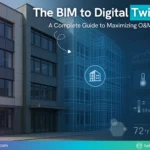Green Buildings: A Catapult for Sustainable Growth in the Construction industry
April 18, 2022

A report jointly published by International Energy Agency (IEA) – United Nations Development Programme (UNDP) states that the buildings and construction sector accounted for 36% of final energy use and 39% of energy and process-related carbon dioxide (CO2) emissions in 2018. This indicates the urgency for adoption of sustainable architecture, principles of environmentally friendly constructure, aka construction of ‘Green Buildings’. Architects and urban planners are, therefore, more inclined, towards looking for sustainable design solutions. There’s a rise in consciousness about greener residential buildings and workspaces among urban dwellers too.
What, then, is a Green Building? According to the US Environmental Protection Agency (EPA), “Green building is the practice of creating structures and using processes that are environmentally responsible and resource-efficient throughout a building’s lifecycle from siting to design, construction, operation, maintenance, renovation, and demolition.” Green buildings Technology are also referred to as high-performance or sustainable buildings as they fully cover the crucial aspects of building design: functionality, durability, economy, and comfort.
While the impact of Green Buildings could be far more expansive, there are a few environmental, social and economic advantages that form the most compelling case in its favour:
Optimization of Resource Efficiency
Green structures can directly impact the reduction of carbon footprint and conservation of energy and water. Improved choice of building materials, design elements that consider light, temperature, water management and evaluation of environmental impact at all stages of the project lifecycle can make a cognizable difference. A study published in 2010 Re?Assessing Green Building Performance: A Post Occupancy Evaluation of 22 GSA Buildings, was conducted on 22 LEED-certified buildings managed by the General Services Administration (GSA), USA. As per this study, these buildings had recorded 34% lower CO2 emissions, 25% less energy consumption, 11% less water consumption and 80 million tons of waste diverted from landfills.
Minimizing Wastage
According to the EPA, the U.S. generated over 600 million tons of construction-related waste in 2018. Efficient construction waste management by minimizing material usage and recycling or reusing construction materials is therefore key to reducing impact.
LEED-certified projects can avoid more than 80 million tons of waste from landfills. With upcycling, use of recycled material, repurposing old structures, this is expected to rise to 450 million tons by 2030
Reduced Operational and Maintenance costs
The construction costs of a green building may be on the higher side compared to traditional buildings. But the asset owners and residents reap the cost benefits post-construction. The sustainable design ensures cost savings on water and energy bills. LEED-certified buildings have nearly 20% lower maintenance costs than typical commercial buildings, and green building retrofits typically decrease operation costs by almost 10% in just one year. The asset value of a green building also increases over time.
Improved Quality of life and Durability for dwellers
Green building design considers comfort along with the functionality, durability, and economic aspects of building design. It has a positive impact on the health and mental well-being of their residents. According to the EPA, heating, and cooling are responsible for around 43% of energy consumption, leading to an increase in greenhouse gases and escalation of air pollution. Green buildings Technology, which use eco-friendly materials, are known to lower air pollutants and improve air quality, thus alleviating potential for allergies & respiratory ailments. Moreover, they are built to withstand the test of time and involve much lower maintenance than traditional buildings.
Offers Opportunities for Design Innovation
Green or sustainable construction invite architects, designers and urban planners to constantly innovate and discover measures which can optimise usage of natural resources like energy and water, reduce wastage of construction materials, reduce carbon emissions & toxic fumes, yet save costs and enhance durability and living experience.
It’s about ensuring sustainable solutions that cover the entire asset lifecycle right from the design phase through construction, post-construction asset operation and maintenance. When it comes to using innovative solutions for green buildings, Building Information Model (BIM) can bring in unexplored benefits. The construction industry across the world is aware of BIM’s role in the design and Virtual Design Construction (VDC). However, BIM’s 3D shared model is highly effective in the construction of LEED-certified green buildings that require the implementation of sustainable measures right from the design stage.
Let’s take a look at how green BIM can aid in designing green buildings.
Real-time Information Accessibility
With BIM’s 3D shared model, design information is accessible to architects, designers, engineers, and other project stakeholders. The data transparency enables the stakeholders to discuss the sustainability of the materials used in the construction or to explore environment-conscious alternatives. Besides, design teams can gauge the energy efficiency of the asset and its impact on the environment during and post-construction.
Efficient Project Planning
The BIM model can also enable workflows to make sure the project meets environmental standards and compliances. Digital construction of the asset helps in understanding the shape of the building and the solar inputs. In the later phases of construction, architects and engineers can enhance energy efficiency, water management, and natural lighting. BIM implementation plan also includes optimum resource management and only required materials are procured thus avoiding on-site wastage.
Improved Asset Management
On the completion of the project, the BIM data can be transferred to asset owners and facility managers. The building data right from the design stage to project completion is available to asset owners for building operation and maintenance. This makes it easier to examine the performance and efficiency of the asset throughout its lifecycle.
Knowing the clear and substantive socio-economic and environmental impact of construction, it is prerogative to co-create a future that is safer, cleaner and economically viable for humanity to thrive on this planet. BIM’s innovative model with its data transferability and improved architectural quality can help us achieve our sustainability goals better and faster.















